Today, we’re going to delve into a topic that’s crucial for every guitarist, regardless of genre: “sustain.” Whether you’re a beginner just starting out or an experienced player looking to refine your technique, using guitar sustain for different musical genres can take your playing to the next level.
Sustain refers to how long a note rings out after being played, and it’s a key element in shaping your sound and expression on the guitar.
You can use the table of contents below to take you to the area that interests you. Click on the little box to open it, and then click on the section of the article you want to read, or you can read from start to finish if you want the full learning experience!
The Short Answer
Using guitar sustain effectively requires understanding its role in different musical genres, as well as the specific techniques, gear, and settings used in each genre. From the warm, singing sustain of a blues slide guitar to the aggressive, sustained power chords of metal, each genre has its own unique approach to using sustain.
Keep On Reading (Below) To Learn More
Understanding Guitar Sustain
Before we dive into the specifics of using sustain in different genres, let’s take a moment to understand what sustain is. In the simplest terms, sustain refers to the length of time a note continues to sound after being played. A note with good sustain will ring out clearly for a long time, while a note with poor sustain will quickly fade away.
Sustain is influenced by many factors, including the type of guitar and pickups used, the settings on the amplifier and effects pedals, and the player’s technique. By understanding how these factors interact, you can learn to control your sustain and use it to enhance your musical expression.
For here for more information on the technical aspects of sustain.
Comparing Sustain Techniques Across Genres

This table provides a quick comparison of the techniques, gear, and settings used to achieve sustain in each genre. Each genre will be visited in more detail in the coming sections.
No matter which genre you play, it’s essential to learn to increase and decrease sustain so that you have control over it at all times!
You can click on each of the genres in this table to learn more.
| Genre | Techniques | Gear | Settings |
|---|---|---|---|
| Rock | String bending, vibrato | Electric guitars with humbucker pickups, overdrive or distortion pedals | High gain on amplifier |
| Blues | String bending, vibrato, slide guitar | Electric and acoustic guitars with single-coil pickups, tube amplifiers | Moderate gain on amplifier |
| Metal | Palm muting | Electric guitars with high-output humbucker pickups, distortion pedals | High gain on amplifier |
| Country | Chicken picking | Electric guitars with single-coil pickups, compression pedals | Clean settings on amplifier |
| Jazz | Legato | Semi-acoustic guitars, tube amplifiers | Clean settings on amplifier |
| Classical | Rest stroke, free stroke | Classical guitars with nylon strings | N/A |
| Flamenco | Trill, alzapúa | Flamenco guitars with nylon strings | N/A |
However, it’s important to note that these are general trends, and there can be a lot of variation within each genre. The best way to learn how to use sustain effectively is to listen to a lot of music, experiment with different techniques and gear, and practice regularly.
Keep On Reading (Below) To Learn More About Each Genre
Rock Guitar
Rock music is known for its powerful, driving sound, and sustain plays a key role in achieving this. It’s characterized by strong rhythms, simple chord structures, and a focus on melody and vocals. The electric and acoustic guitar is a central instrument in rock music, often used for rhythm and lead parts.
Techniques, Gear, And Settings
Rock guitarists often use electric guitars with humbucker pickups, which provide a thicker, warmer tone with more natural sustain than single-coil pickups. Overdrive or distortion pedals are commonly used to increase sustain by clipping the guitar’s signal, adding harmonic content, and making the note ring out longer. Tube amplifiers are preferred for their warm tone and natural compression, which can also increase sustain.
In terms of playing techniques, rock guitarists often use string bending and vibrato to add energy to the string and increase sustain. Additionally, playing loudly and with a strong attack can help to increase sustain.
Guitarists Known For Their Use of Sustain
Famous rock guitarists known for their use of sustain include David Gilmour of Pink Floyd, whose solos often feature long, singing notes, and Slash of Guns N’ Roses, who uses sustain to add drama and intensity to his solos.

David Gilmour

Blues Guitar
The blues genre is all about conveying emotion and expression, and one important tool for blues guitarists is sustain. This style is known for its use of “blue” notes, swung rhythms, and repetitive chord progressions, usually with a 12-bar structure. The guitar is a vital instrument in blues music, with a focus on individual notes and emotive bends and slides.
Techniques, Gear, And Settings
Blues guitarists often use both electric and acoustic guitars, with single-coil pickups preferred for their clear, biting tone. Tube amplifiers and overdrive pedals add sustain and warmth to the sound. Slide guitar playing, which involves sliding a glass or metal tube along the strings, creates a sustained singing tone.
Guitarists Known For Their Use of Sustain
Famous blues guitarists known for their use of sustain include B.B. King, whose signature “butterfly” vibrato adds sustain and expressiveness to his notes, and Derek Trucks, who is known for his expressive slide playing and long, singing sustain.
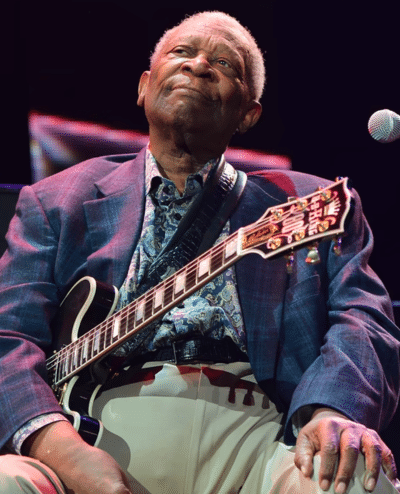
B. B. King

Metal Guitar
Metal is a genre that’s all about power and intensity, and sustain is used to create a thick, heavy sound. This genre is characterized by its heavy use of power chords, fast and intricate solos, and aggressive rhythms. The electric guitar is a central instrument in metal music, often used for both rhythm and lead parts.
Techniques, Gear, And Settings
Many metal guitarists prefer using electric guitars equipped with high-output humbucker pickups for a fuller and more sustained sound. They also use distortion pedals and high-gain amplifier settings to enhance their unique sound further. To control sustain and create a punchy and tight sound, palm muting is commonly utilized by metal guitarists.
Guitarists Known For Their Use of Sustain
Famous metal guitarists known for their use of sustain include Tony Iommi of Black Sabbath, who uses heavy distortion and power chords to create a thick, sustained sound, and Kirk Hammett of Metallica, who uses sustain to add intensity to his fast, intricate solos.

Tony Iommi

Country Guitar
In country music, you’ll typically hear clean, twangy guitar tones with sustain added in a controlled manner to enhance the sound’s depth and richness. This genre is known for its simple yet catchy melodies, strong rhythms, and storytelling lyrics. The electric and acoustic guitar play a central role in country music, serving as both the rhythm and lead instrument.
Techniques, Gear, And Settings
Country guitarists often use electric guitars with single-coil pickups (typically a Fender Telecaster), which provide a bright, clear tone with moderate sustain. Compression pedals are commonly used to even out the guitar’s dynamics and increase sustain. In terms of playing techniques, country guitarists often use a technique called chicken picking, where the strings are plucked in a way that creates a sharp, percussive attack and a short, controlled sustain.
Guitarists Known For Their Use of Sustain
Some of the most renowned country guitarists recognized for their exceptional use of sustain are Brad Paisley and Vince Gill. Brad Paisley incorporates compression and overdrive into his fast, intricate solos to enhance the sustain. On the other hand, Vince Gill uses sustain to augment the depth and richness of his solos.
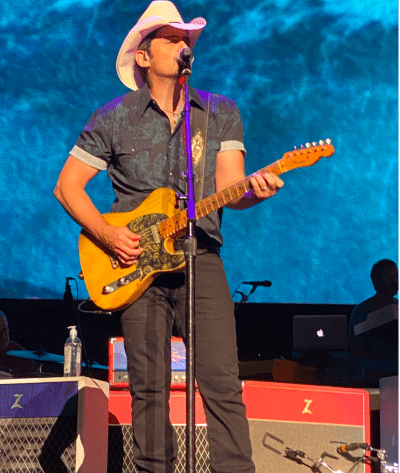
Brad Paisley
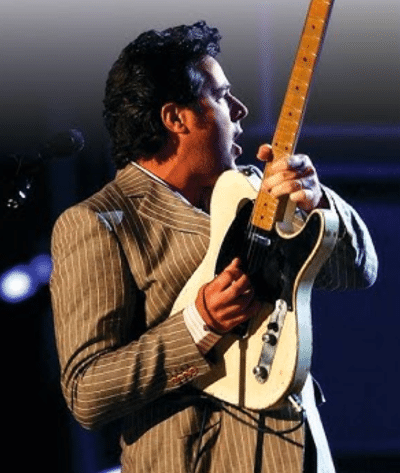
Jazz Guitar
Jazz is a genre that values subtlety and nuance, and sustain is used in a more controlled and deliberate way than in rock or blues. It’s characterized by its complex harmonies, improvisation, and swing rhythms. The electric and acoustic guitar is often used in a rhythm role, providing chordal accompaniment to other instruments, although melodic solos are also common.
Techniques, Gear, And Settings
Jazz guitarists often use semi-acoustic guitars, which have a hollow body that provides natural sustain and a warm, rich tone. Tube amplifiers are preferred for their clean, warm sound, and effects pedals are used sparingly, if at all. In terms of playing techniques, jazz guitarists often use a technique called legato, where notes are connected smoothly together to increase sustain.
Guitarists Known For Their Use of Sustain
Famous jazz guitarists known for their use of sustain include Wes Montgomery, who used his thumb to pick the strings, creating a warm, sustained tone, and Pat Metheny, who uses a combination of legato playing and guitar synth effects to create long, sustained notes and chords.
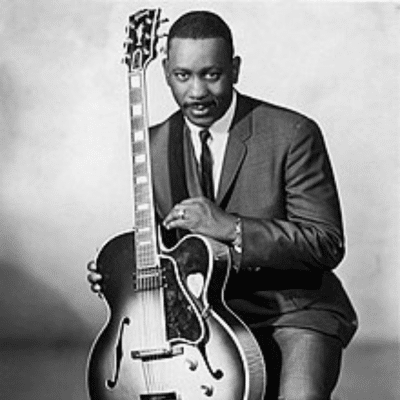
Wes Montgomery
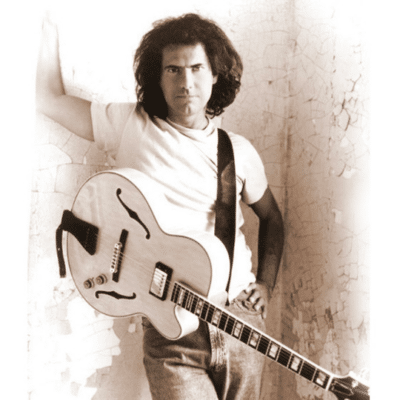
Classical Guitar
Classical music requires a delicate and controlled approach to sustain, with a focus on clarity and expression. It’s characterized by its complex harmonies, intricate melodies, and a wide range of dynamics. The classical guitar, which is an acoustic instrument with nylon strings, is often used for solo pieces as well as ensemble playing.
Techniques, Gear, And Settings
Classical guitarists use a variety of right-hand techniques to control sustain, including rest stroke (where the finger comes to rest on the next string) and free stroke (where the finger does not touch the next string). These techniques, along with careful control of finger pressure and position, allow classical guitarists to achieve a wide range of sustain effects.
Guitarists Known For Their Use of Sustain
Famous classical guitarists known for their use of sustain include Andrés Segovia, who was known for his expressive use of dynamics and sustain, and Julian Bream, who uses a variety of right-hand techniques to control sustain and create a wide range of tonal colors.

Andrés Segovia
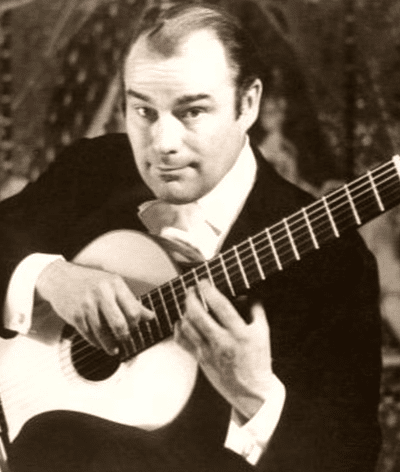
Flamenco Guitar
The genre of flamenco is known for its passionate and intense nature, where sustain is utilized to create a deeper and richer sound. Its unique features include complex rhythms, intricate fingerpicking patterns, and emotional intensity. The flamenco guitar, which has a thinner body and less sustain compared to a classical guitar, is utilized for both rhythm and lead parts.
Techniques, Gear, And Settings
Flamenco guitarists often use techniques such as the trill (rapid repetition of a single note) and alzapúa (a thumb technique that combines a downstroke and an upstroke) to increase sustain. The flamenco guitar is designed to have less natural sustain than a classical guitar, which allows the guitarist to play fast, intricate passages without the notes blurring together.
Guitarists Known For Their Use of Sustain
Two famous flamenco guitarists are known for their use of sustain: Paco de Lucía and José Fernández Torres, also known as Tomatito. Paco de Lucía was known for his fast and intricate playing and his controlled use of sustain. Tomatito, on the other hand, uses sustain in his solos to produce a more profound and fuller sound.

Paco de Lucía

Key Takeaways

Here are three things to remember about sustain.
- Each genre has its own unique approach to using sustain, from the high levels of sustain used in rock and metal to the more controlled and subtle approach used in jazz and classical music.
- There are many ways to increase sustain on your guitar, including using certain types of gear and playing techniques.
- Many famous guitarists are known for their use of sustain, and studying their playing can provide valuable insights into how to use sustain effectively.
Frequently Asked Questions

Here are some of the questions I get asked about sustain.
If your question does not appear here, please put it in the comments, and I will get right back to you with an answer.
How Can I Practice Controlling My Sustain?
Practicing techniques like string bending, vibrato, and legato can help control sustain. Also, experimenting with different gear and settings can enhance your understanding of how they affect sustain.
How Does The Volume Of My Playing Affect Sustain?
Playing at a higher volume can increase sustain as the increased energy from the amplifier speakers causes the strings to vibrate longer. However, it’s essential to control volume to avoid unwanted feedback.
How Does The Attack Of My Playing Affect Sustain?
The attack, or how hard you strike the strings, can affect sustain. A harder attack can increase sustain, but it’s important to maintain control to avoid unwanted noise.
Where Does Sustain Come From On A Guitar?
Sustain on a guitar comes from the vibration of the strings. When you pluck a string, it vibrates and produces sound. Factors such as the type of guitar, the materials it’s made from, the setup of the guitar, and the way you play it can all affect sustain.
How Does Guitar Scale Length Affect Sustain?
Generally, guitars with longer scale lengths can have more sustain because the strings are under more tension, which allows them to vibrate for a longer period of time. However, other factors, such as the guitar’s construction and the player’s technique, can also significantly influence sustain.
How Can I Use Sustain To Enhance My Solos?
Sustain can make your solos sound fuller and more expressive. Techniques like string bending and vibrato can increase sustain, and using effects pedals or a tube amplifier can further enhance it.
Final Thoughts – add keyword

In the world of guitar playing, understanding and using guitar sustain for different musical genres is a key aspect of mastering your instrument. The ability to control the length of your notes, to let them ring out or cut them short, can dramatically affect the emotion and impact of your music. Each genre has its unique approach to sustain, reflecting its distinct musical characteristics and expressive needs.
From the powerful, ringing chords of rock, the soulful bends of blues, the subtle nuances of jazz, the twangy licks of country, the heavy riffs of metal, to the intricate melodies of classical and flamenco music, sustain plays a crucial role. It’s the invisible thread that weaves through every note, every chord, every solo, binding them together into a coherent musical statement.
But remember, while gear and techniques can help you achieve the sustain you desire, the most important factor is you, the player. Your touch, your feel, your emotion – these are what breathe life into the notes and make them sing. So, don’t be afraid to experiment, to explore, to push the boundaries of what you can do with sustain.
In the end, using guitar sustain for different musical genres is not just about making your notes last longer. It’s about finding your unique voice on the guitar and sharing it with the world. So pick up your guitar, let your notes ring out, and let the world hear your music!

Don’t Worry About The Guitar You Play!
Here’s a great video from “Music Is Win” that demonstrates that the type of guitar you play isn’t the most important factor in defining the sound of a musical genre.
It reminds me of a friend that used to play Broadway show tunes on a Gibson SG guitar, and they sounded fantastic!
Be sure to check out this video!
What To Read Next ➡ How To Get More Sustain On Clean Guitar Tone – Pro Insider Tips!
Tell Me What You Think

Please leave a comment below if you enjoyed this article, have any questions about guitar sustain, or want to give your point of view. I will be happy to help you.
- What guitar do you use for the musical genre you play? Why?
- Is playing technique more important than equipment for sustain?
- How do you use your guitar, effects, and amp to dial in sustain?
- What else is on your mind?



This is a brilliant post. As a beginner I feel better having watched your recommended video “Music Is Win”, as I’ve been having second thoughts on the guitar I recently purchased. It’s actually more important finding the balance that suits your playing style and musical genre than the actual guitar. I do have a question. How does the use of sustain, along with techniques like palm muting, contribute to the distinctive power, intensity, and sonic characteristics of metal guitar playing?
Hi, Jessica
I really appreciate your comments and compliment!
You are correct in saying that the guitar you already have is secondary to defining what is most important in your playing style.
Sustain can complement or detract from playing techniques, depending on how it’s used and the settings on your guitar, amp, and any pedals in your rig. With palm muting in Metal, you’re mostly looking for a very percussive sound with a tight bottom end.
Please let me know if you have any other questions! 😎
Rock On! 🤘
Frank 🎸
Hello Frank!
I’m really intrigued by the concept of using guitar sustain for different musical genres, as I’m fairly new to playing the guitar and I’m just starting to understand the importance of sustain. I’ve been exploring a bit with rock and blues genres on my guitar, and I’ve noticed that sustain can really make a difference in the overall sound and feel.
I was wondering, as a beginner, how do you recommend practicing and improving my control over sustain? I noticed you mentioned techniques like string bending, vibrato, and legato. Are there specific exercises or practice routines you could suggest to help me develop these techniques effectively? Also, since you mentioned that each genre has its own approach to sustain, how do I know when to use these techniques for different genres? Is there a rule of thumb or some guidelines to follow?
Thanks for sharing your insights!
Hi, Skamalka
Thank You for your comments and questions!
The best way to begin learning to create and control sustain is to practice string bending, vibrato, and legato. You can find many helpful YouTube videos on these techniques.
To learn the best ways to apply them to various musical genres, listen to songs by your favorite bands.
After learning the rudiments, you can experiment with creating sustain by adjusting the controls of your guitar, amp, and effects pedals (especially a compressor).
Have Fun & Rock On! 🤘
Frank 🎸